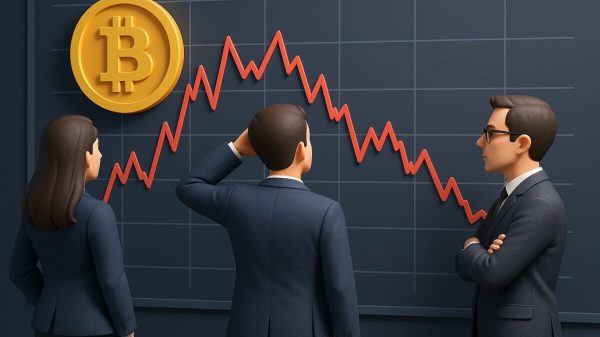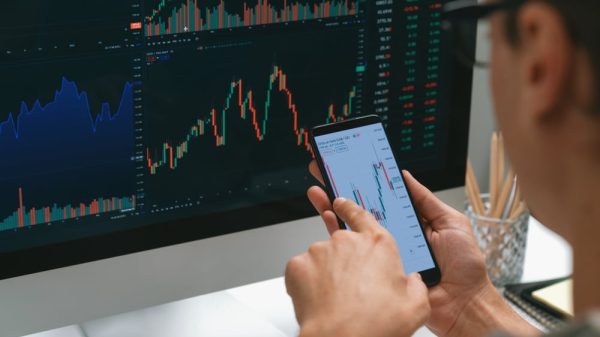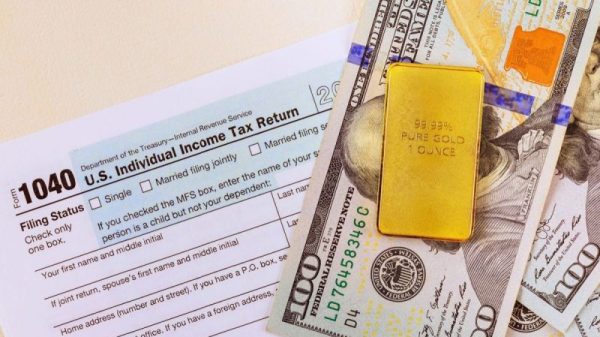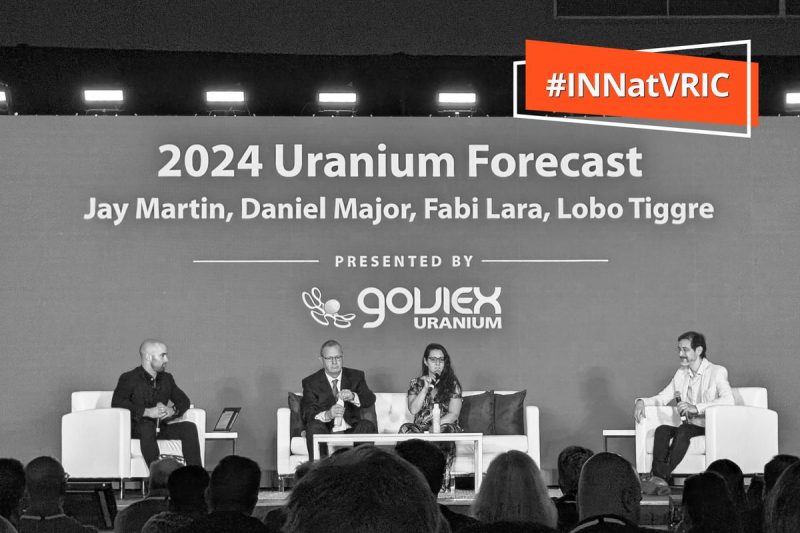Uranium was a hot topic at this year’s Vancouver Resource Investment Conference (VRIC).
The energy commodity recently broke through the US$100 per pound barrier for the first time since 2007, and investors were keen to hear top experts discuss why uranium is finally taking off and how to strategize at this stage.
What’s driving uranium demand?
Uranium industry insiders speaking at this year’s VRIC identified a number of demand drivers, including UN climate change conference COP28, the Inflation Reduction Act in the US and artificial intelligence (AI) technology.
At COP28, which was held in Dubai toward the end of 2023, more than 20 countries from four continents signed a declaration to triple nuclear capacity by 2050 in order to help the world reach net-zero targets. Furthermore, as part of the nation’s clean energy transition, the US has pledged to use up to US$500 million in funds allocated under the Inflation Reduction Act to build out domestic uranium supply for advanced nuclear reactors.
“It feels like we woke up one day and we came to the conclusion globally at the same time that we can’t achieve net zero — we can’t decarbonize while meeting growing energy needs globally — without nuclear power,” said Amir Adnani, CEO of Uranium Energy (NYSEAMERICAN:UEC), in a fireside chat with Jay Martin of Cambridge House International. “There isn’t a single climate scientist on the planet that has looked at modeling how you decarbonize while meeting energy needs and (hasn’t) concluded that we need nuclear power. So that’s why the policy shifted significantly.”
On the demand side, Adnani also pointed to important drivers like Russia’s invasion of Ukraine, which has driven up energy prices, and nuclear power’s return to favor in places like Japan and the US.
These sentiments were shared by Fabi Lara, founder of the Next Big Rush newsletter. The growing acceptance of nuclear power as a clean energy source has led countries to extend the lives of their nuclear power plants, which Lara said is translating into more immediate demand for uranium in the current market landscape.
In her workshop “Uranium is Flying — What’s Next?” Lara told attendees that the market has entered a new contracting cycle after a decade of underinvestment on the part of utilities. Beginning in 2023, she explained, “utilities started to purchase pounds in order to … fill their cupboards” and meet their longer-term supply needs.
Another interesting catalyst for future uranium demand could come out of the AI technology sector, said UEC’s Adnani, highlighting a recent MIT study about the carbon emissions associated with the sector.
“MIT just came out with a study that shows one image generated by AI consumes the same amount of energy as you recharging your phone. Think about that,” he told VRIC attendees. “So why is it that Bill Gates, Sam Altman and Elon Musk and companies like Amazon (NASDAQ:AMZN) and Google are talking about nuclear energy? Because they’re looking at the … consumption of energy (needed) to power new data centers that’s going to power their AI dreams.”
Adnani said this high level of energy consumption from the tech sector is leading to demand for advanced small modular reactors, which can be located next to data centers to provide power. He pointed out that Microsoft (NASDAQ:MSFT) has already announced plans to buy and install small modular reactors.
“That’s why Amazon, Google, Walmart (NYSE:WMT) — any company that wants to automate and has a plan around AI — needs to think about how to power that. We haven’t seen this kind of step change in power consumption in the west in over 100 years,” he explained. “Then that’s where nuclear comes in, on top of all the favorable policy that says if we’re going to decarbonize, we need nuclear in order to meet this growing energy demand.”
Uranium supply challenges not going away
As uranium demand builds, supply is noticeably lagging behind after years of tough market conditions.
Daniel Major, CEO of Africa-focused GoviEx Uranium (TSXV:GXU,OTCQX:GVXXF), spoke about the supply challenge during a panel at VRIC. He told attendees that the uranium industry still has a long way to go when it comes to addressing the “fundamental reasons of why” the uranium spot price has returned to triple-digit territory.
“It is a long-term problem. We’re massively underinvested from an exploration point. We are at one-third of where investment levels were back in 2007/2008,” he noted. Major sees global competition for uranium resources heating up in the coming years if new mines are not brought online, particularly given that China is projected to see its annual consumption of the nuclear fuel input rise from 11,000 metric tons in 2023 to 44,000 metric tons by 2040.
Adnani also sees underinvestment in uranium exploration and development as a significant driver of supply-side challenges, especially with governments allocating capital to extend the life of existing reactors by several years.
“That’s why the business has grown fundamentally on the demand side into a big positive. Now, here’s the interesting thing. In the US, they’re talking about extending the life of existing reactors from 50 years to 70 years to 80 years. So with a signature … you extend the life of a reactor by 20 years. Can I extend the life of a mine with a signature?” Adnani asked the audience at VRIC. “A mine is depleting, a mine has a finite life.’
Western countries and utilities are also facing increasing challenges as they look to secure domestic supply. Adnani, whose company is slated to restart production at its Wyoming-based Christensen Ranch in situ recovery operation in August, said major catalysts for uranium this year include a proposed US ban on Russian-produced unirradiated low-enriched uranium, and increased buildup in the US’ strategic uranium stockpile.
“The largest consumer of uranium in the world, the government of the US, has set up a strategic reserve to buy uranium for the government account. The last time the US government was buying uranium for the government account was the 1950s. Think about that,” he said. “This is not an every decade thing. It’s quite rare. And uranium, it really does matter where it comes from and what the location is. The US government can only buy US-mined uranium.”
Are higher uranium prices sustainable?
Uranium prices have been in the doldrums for so many years that the commodity’s recent price rally has many in the sector seeing room for even higher prices; however, others see reason for some caution.
Lobo Tiggre, CEO of IndependentSpeculator.com, reiterated his uranium bull bonafides at VRIC, but said he’s watched the space long enough to know not to get carried away by “irrational exuberance.’
“Yes, everybody’s talking about Kazatomprom (LSE:59OT,OTC Pink:NATKY) saying, ‘Well, we may not be able to ramp back up as much as we want.’ But it’s not, ‘We’re going to produce less.’ It’s (rather) ‘not ramp up as much as we thought.’ And the low-hanging fruit is being built. There are mines that are coming online,” explained Tiggre.
His biggest concern is the physical uranium bought through investment funds. “This new secondary source of all these people that bought in at US$30, US$40, US$50 … You didn’t buy this on spot to sequester it forever. You bought it to buy low, sell high. What are you going to do when you’re sitting on it?” he asked. “I am not saying the uranium price is about to tank. I’m saying there’s a new variable here. This has never happened before. We don’t know what will happen. I don’t know how much secondary supply will come out of the market. But it is a variable for this year.”
Adnani had much to say about uranium prices as well. He noted that according to the Nuclear Energy Institute in Washington, DC, which tracks expenses for all nuclear utilities in the US, the cost for nuclear fuel represents 5.4 percent of the total cost of nuclear reactor energy generation, and the cost of uranium is only one-third of that.
“So that uranium price is only nearly 2 percent of the overall cost of power generation. It’s nothing. That means we have price inelasticity. Unlike a natural gas-fired power plant where gas prices are 70 percent or more of the cost of power generation,” he said. Adnani went on to explain that under the Inflation Reduction Act, the US government is providing billions of dollars of support and credit to nuclear utilities. In his view, the most important takeaway for investors should be that there is room for higher uranium prices for longer because utilities can tolerate it.
Uranium stock opportunities still exist
The uranium spot price may have doubled in the past six months, but not all uranium stocks have come along for the ride. Many of the experts on stage at VRIC view this as an opportunity to get into the sector at a discount.
“Yes, uranium the commodity is finally at triple digits … But the issue is that the equities have by and large not reached their 2021 highs,” said Lara while speaking at the event. “Obviously, you know, some companies are doing really well. But by and large, we haven’t seen the mania yet. So I’m looking at this market … Yes, the commodity is working. (But) the equities are lagging and I think there’s opportunity there.”
Many of the speakers are interested in companies with established resources in the late development stages.
“I like the development space in particular,” said Tiggre. “I’m looking for a credible, robust feasibility study that’s at a price below the accepted incentive level.” Targeting companies with projects that are still economically feasible at lower prices takes out some of the risk of uranium trending to lower levels again.
He’s also interested in developers just hitting the “pre-production sweet spot.” When it comes to current producers, Tiggre prefers those that are already turning a profit.
Investor takeaway
There are plenty of good reasons for investors to be excited about uranium and the bright future for this energy metal. For one, nuclear power is increasingly taking center stage as a strategic bridge in the transition away from fossil fuels to cleaner energy sources. For another, these demand-side dynamics are unfolding at a time when the uranium sector has yet to dig itself out of a supply crunch caused by years of underinvestment.
The fact that many uranium stocks have yet to see these factors play into their valuations may present a window of opportunity for those investors still sitting on the sidelines.
Securities Disclosure: I, Melissa Pistilli, currently hold no direct investment interest in any company mentioned in this article.


































